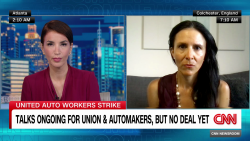The United Auto Workers union’s already unprecedented strike against General Motors, Ford and Stellantis could soon get even bigger.
As the strike entered its fifth day Tuesday with the two sides apparently far apart, the union is threatening to expand the strike as soon as noon this Friday.
This is the UAW’s first strike against all of the traditional “Big Three” automakers simultaneously. So far, the strike, which started early Friday, has targeted only one final assembly plant at each automaker. But UAW President Shawn Fain announced Monday night that it would pick other plants if there is no “substantial progress” in the offers from the automakers.
“Autoworkers have waited long enough to make things right at the Big Three. We’re not waiting around, and we’re not messing around. So, noon on Friday, September 22nd is a new deadline.”
While 12,700 union members are on strike, most of the 145,000 members at the three automakers remain on the job.
But after talks throughout the weekend and on Monday, the union is not scheduled to have any “main table” meetings with lead negotiators scheduled for Tuesday, a source with knowledge of the meetings told CNN.
The next main table meetings with both sides are scheduled with GM and Ford on Wednesday, and Stellantis on Thursday, the source said.
However, the timing of those main table talks could move up, after Fain’s new deadline was given late Monday, the source added.
The UAW chose to target final assembly plants first, which has made the initial strikes quite targeted and tactical. While the temporary closure of a final assembly plant is designed to cause some pain, a strike of such a final assembly plant is not devastating in the short-term, as it would only effect the vehicle models that are assembled there.
The UAW has room to escalate things drastically should it so choose, however, with the Big Three’s key engine and transmission plants particularly vulnerable. If a plant that makes only the Ford Bronco and Ford Ranger is being struck, like the one in Wayne, Michigan is right now, only the Ford Bronco and Ranger are going to face a production halt.
But every non-electric car requires an engine and a transmission. If the UAW takes the engine and transmission plants down, it could essentially idle all of the companies’ North American production.
So a great deal rides on what plants the union targets with this next round of strikes on Friday if it doesn’t see the progress it says it needs in negotiations.
Companies say they want deals
The companies say they remain committed to reaching deals that will end the strike.
“We’re continuing to bargain in good faith with the union to reach an agreement as quickly as possible for the benefit of our team members, customers, suppliers and communities across the US,” said a statement from GM
Stellantis, which makes vehicles for the US market under the Jeep, Ram, Dodge and Chrysler brands, said it held “constructive” talks with the UAW on Monday “focused on where we can find common ground to reach an agreement.”
“We continue to listen to the UAW to identify where we can work together and will continue to bargain in good faith until an agreement is reached. We look forward to getting everyone back to work as soon as possible,” said Stellantis’ statement.
“We continue to negotiate with the UAW and our focus is on reaching a deal that rewards our employees, allows for the continuation of Ford’s unique position as the most American automaker and enables Ford to invest and grow. We are developing responsible contingency plans for further work stoppages,” said a statement from that company.
Another strike on hold in Canada
There was one hopeful sign of progress amid all the labor disruptions roiling the industry, but it came from Canada, not the United States.
Unifor, the Canadian union that represents more than 5,000 workers at Ford, put plans to go on strike late Monday night on hold after it said that Ford had made a “substantive offer” just minutes before the 11:59 pm ET deadline. The union gave the automaker a 24-hour extension of the existing contract and the two sides negotiated through the night there, Unifor President Lana Payne told CNN Tuesday morning.
Several hours before the original Monday deadline Payne had warned members that the two sides were far apart and they should be prepared to strike. The extension was short of a deal and a strike is still possible. But the extension was a rare piece of good labor relations news for an auto industry that is reluctant to meet workers’ demands at the bargaining table. It suggested that even when a union and management appear far part, that gap can be closed.
Spreading impact of strike
The impact of the strike will have a ripple impact on other factories beyond the three targeted already by the UAW strike. GM has already announced plans to temporarily shut production at its Fairfax Assembly plant in Kansas City, Kansas, because it depends upon stampings from the nearby Wentzville Assembly plant that the UAW is striking at GM. The Fairfax plant will likely operate through the day Tuesday and be shut early Wednesday, according to GM spokesman David Barnas.
And auto suppliers will soon start slowing or stopping output as well. On Monday, US Steel announced it was idling the blast furnace at its steel mill in Granite City, Illinois, just outside of St. Louis, due to the expected impact from the UAW strike.
“We do not take these decisions lightly and will continue to monitor and assess market conditions,” said a statement from the steelmaker.
Gap remains in talks
Ford, GM and Stellantis are all on the record saying that they have offered UAW members about 20% in raises over the four-year life of the contract, including an immediate 10% raise.
The UAW, which began negotiations demanding an immediate 20% raise and raises totaling 40% over the following few years, has said that the offer is not sufficient, considering the record or near-record profits the automakers are reporting, and how much ground its members have lost due to past contract concessions and inflation that has outstripped salary gains in recent years.
The union is also very concerned about future job losses that could come from the plans of the automakers to convert from traditional gas-powered cars to electric vehicles. It takes about 30% less labor to assemble an EV, due to fewer moving parts. That has caused some critics of the Biden administration, including former President Donald Trump and former Vice President Mike Pence, to blame the strike on the administration’s support of the transition to EVs.
Fain attacks Trump
Trump, who is expected to hold a rally in Detroit next week has been critical of both the automakers and the UAW leadership for not doing more to fight the transition to EVs.
“Both the UAW bosses and the big three auto executives should be screaming at the top of their lungs – they should be ashamed of themselves – demanding that Joe Biden cancel his brutal electric vehicle mandate before it destroys the entire US auto sector,” Trump said in a speech earlier this month, apparently referring to proposed emission rules from the EPA that could require EVs to make up two-thirds of new vehicle sales by 2032.
Fain, who has been critical of Biden and some of his policies related to EVs, attacked Trump late Monday after reports that he would coming to Detroit next week rather than attending the second Republican presidential debate.
“Every fiber of our union is being poured into fighting the billionaire class and an economy that enriches people like Donald Trump at the expense of workers,” said Fain in an emailed statement. “We can’t keep electing billionaires and millionaires that don’t have any understanding what it is like to live paycheck to paycheck and struggle to get by and expecting them to solve the problems of the working class.”























